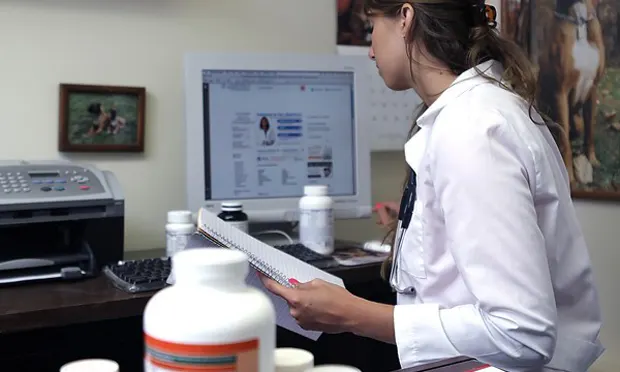Should Your Practice Have an Online Pharmacy?
Pamela D. Stevenson, CVPM, VetResults, Durham, North Carolina

Clients today are trying harder than ever to save money, and ordering veterinary drugs online rather than through human pharmacies has increased in popularity.1 Pharmacy income is a significant component of overall practice health; thus, meeting clients' evolving demands by developing your own online pharmacy service should be seriously considered.
A practice’s online pharmacy benefits clients more than just attracting them in-house; most rebates and manufacturer guarantees are available only for drugs dispensed by the veterinarian. Furthermore, most outside pharmacies do not use veterinarians and rely on staff inexperienced in pet prescriptions. Some online pharmacies now even offer their own “guarantee” for certain products.2
The Procedure
Setting up an online pharmacy is quick and easy. First, select a provider (eg, Vets First Choice, Vet Source, Vetstreet). Then, decide how to incorporate the pharmacy into your practice, and choose your internet presence and practice management software. Also, decide whether you want to actively market the service or suggest it only when a client requests a prescription.
Fifty-six percent of practices surveyed recently had their own online pharmacy, the majority of which had less than $6,000 in annual sales,3 so active promotion should be considered. However, this may change as the number of veterinary practices with their own online pharmacies increases, clients become familiar with such pharmacies, and more sales result.
The Process
Every practice needs an established protocol for handling prescription refill requests. Here is one process:
The refill request is received via telephone, fax (see item 4), internet, or in person. The client should be informed that the normal approval process for a refill request is 24 hours and he or she will be contacted when the request is approved and/or ready for pick-up.
The request is forwarded to the veterinarian who manages that patient.
The veterinarian in turn forwards the patient’s chart (or electronic medical record) and the refill request to a technician, indicating his or her decision to approve the request and noting any changes to the prescription or reasons why the refill is denied.
The technician either fills the medication in-house or sends the approval to the requesting pharmacy, and then contacts the client. (Note: Many practices do not accept requests faxed from an outside pharmacy; with the client’s permission, they either transfer the prescription to their own pharmacy or directly contact the outside pharmacy to approve or deny the prescription.)
The veterinary technician, on the veterinarian’s order, lists the number of refills available and prescription expiration date. (Note: Many practice management software programs that can track pre-approved refills within a specific time period are now available.)
If the veterinarian denies or postpones the request, the veterinary technician lets the client know that the prescription cannot be filled until criteria that the veterinarian specifies (eg, examinations, laboratory work, diagnostic tests) have been performed. It is important to explain to the client that the veterinarian wants to ensure that the medication prescribed continues to be appropriate and causes no harm.
Calling clients to inform them their refill has been denied because more information is required about the patient is difficult for any veterinary team member. Many clients willingly comply with the veterinarian’s requests and will make an appointment to do whatever is necessary to get the refill approved, but if this is not the case, the conversation with the client can be critical to maintain or build the client relationship. It is important to take the time to carefully explain why the examinations, laboratory tests, or diagnostic tests are necessary before the prescription can be approved.
Conclusion
Every veterinary practice should have its own in-house and online pharmacies and the veterinary team should be able to educate clients about the reasons prescriptions are necessary for the patient’s well-being, emphasizing the personal service they provide compared with outside online drug services or human pharmacies. The AVMA and the FDA provide good resources for client education and team training.4-6